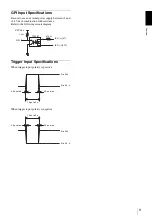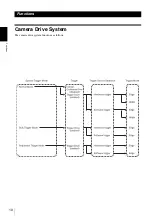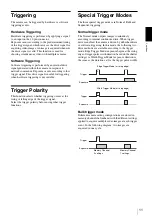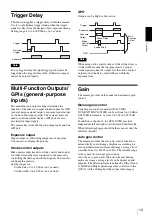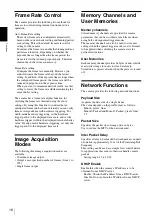
Ov
e
rvi
ew
3
Overview
The XCG-V60E/XCG-SX97E/XCG-U100E/
XCG-5005E is a monochrome digital video camera
module that supports 1000BASE-T interface.
Features
GigE Vision-compliant
Conforming to GigE Vision version 1.0 standards, this
unit is capable of transmitting uncompressed images at
high efficiency.
High image quality
Progressive-scan CCD produces high-precision, high-
speed images.
The XCG-V60E equips a 330,000-pixel CCD that
enables image output at 90 frames per second.
The XCG-SX97E equips a 1,450,000-pixel CCD that
enables image output at 16 frames per second.
The XCG-U100E equips a 2,000,000-pixel CCD that
enables image output at 15 frames per second.
The XCG-5005E equips a 5,000,000-pixel CCD that
enables image output at 15 frames per second.
By adopting square pixels, images can be processed
using the original aspect ratio without a converting
procedure.
Body fixing
The screw holes to install the camera module are located
under the front panel (the CCD reference plane).
Installing the camera module on the front panel
minimizes deviation of the optical axis.
Various mode settings
The following mode settings can be configured via
controls from the host device.
• Gain
• Read mode: Normal/Binning
• Partial scan
• Shutter: Normal/Trigger shutter
• Shutter speed
• Gamma
• Switching an output Bit Length
• Binarization
External trigger shutter function (2 to
1/100,000 sec.)
You can obtain still images by synchronizing with
external trigger signals and operating the shutter at your
own timing. This function is useful to shoot a
fastmoving object clearly.
Partial scan
The camera module can limit the number of effective
video output lines to achieve high frame rates, enabling
high-speed image processing.
Frame rate control
You can change the frame rate while maintaining the
shutter setting. This is useful when you want to reduce
packet sizes per time by lowering the frame rate and
reduce network traffic.
Note
Normal connection between the camera and the host
system may not be established if the camera is turned on
before system initialization is complete on the host
device. Wait for completion of host device system
initialization before turning on the camera.









